

Helleborus niger Linn.
The Christmas rose is the best known and certainly the showiest of the species hellebores; it has long been associated with Christmas, the New Year and a longing for spring. But it can be a frustrating garden plant for although it has been grown in gardens for hundreds of years and is universally known by this enticing common name, how often do we actually see it in flower at Christmas? The German name of Schneerose (snow rose) is perhaps more appropriate. True, there is a form known as 'Praecox' which is said to flower at Christmas but do we ever see it? 'Higham's Variety' sounds similar but we cannot yet vouch for it. E. A. Bowles and others have maintained that 'Praecox' flowered in September and who are we to doubt the great plantsman?
This is a very distinct species, immediately recognisable and rarely confused with others, but at the same time rather variable in the size and number of its flowers; some forms sold are poor plants with weak growth, small flowers and not very many of them. In the garden it can be rather particular and is rarely seen growing in such luxuriance as we would all like.
Much used in herbal medicine this species was said by Parkinson to be 'good for mad and furious men, for melancholy, dull and heavie persons, and briefly for all those with blacke choler, and molested with melancholy.'!
Description
An evergreen perennial generally reaching 9-12in (23-30cm) in height with a woody, rhizomatous root system. The leaves are leathery and dark green in colour although in weak specimens they may well become pale and yellowish. On mature plants they are pedately divided into seven, eight or nine segments; there is little variation in this feature. The individual segments are untoothed, except sometimes towards the apex. In the wild the leaves generally overtop the flowers, or they would if they stood upright but they are often flattened by the snow. In gardens, forms have been selected in which the flowers overtop the leaves.
The flowers are carried on rounded fleshy stems varying from 3in to 9in (7.5-23cm) in height, which may be plain green or spotted with purple. There is usually only one flower per stem, although there may occasionally be two or even three, and the flowers usually open flat and are generally 11/2-3in (4-7.5cm) across although they can be larger in selected forms. The individual petals may be 3/4-11/2in (2-4cm) long and 1/2-11/2in (12mm-4cm) wide and while some forms are quite starry in shape most are more full and rounded.
This species is generally credited with pure white, though green eyed, flowers. However the flowers may be pink in bud or on the backs of the petals or may develop pinkish tints as the flowers age; there are also forms which rapidly age to dark pink, almost red.
In gardens the flowers generally appear from January to March, occasionally earlier, though in the wild plants may still be flowering in June in some high, cold areas. There are up to twenty green nectaries, a large number of stamens and between five and eight carpels although some may not mature fully.
To the botanist the features which distinguish H. niger from other species are the undivided bracts, the noticeably prominent elaiosome on the seeds which anyone sowing fresh seed will have noticed and the smooth pollen grains. To the gardener the large, pure white, waxy flowers carried singly on stiff upright stems and the dark, leathery, almost untoothed foliage make it easily distinguishable.
Helleborus niger subsp. niger
This subspecies has deep green foliage, sometimes with a few teeth towards the apex, and flowers up to about 23/4in (7cm) across.
Natural distribution and habitat
Plants from most areas of the range come under susbp. niger. Basically this is a plant of the mountains, reaching from the Alps of Switzerland, southernmost Germany and Austria, through Slovenia and into Croatia together with northern Italy.
This is an adaptable plant, growing sometimes in woods and at other times out in the open on alpine slopes. Near Lake Bled in northern Yugoslavia it grows in pine or mixed woodland where it relishes a good depth of old leaf mould although it still may not grow all that vigorously. Higher up it grows in the open, possibly in areas where there was once tree cover. In this area Elizabeth Strangman has seen it in woods with Anemone nemerosa, A. trifolia, several different cardamines including C. kitaibelii, Crocus vernus subsp. albiflorus, Cyclamen purpurascens, Daphne mezereum, Epimedium alpinum, Galanthus nivalis, Gentiana asclepiadea and G. verna, Hacquetia epipactis, small flowered Hepatica nobilis in blue and pink, Omphalodes verna, Polygola chamaebuxus, Primula vulgaris, Pulmonaria officinalis and Veratrum nigrum.
In Croatia Elizabeth found this plant growing in thick leaf mould on limestone in woods made up of oak, pine and beech. It grew with Asarum europaeum, various cardamines, Epimedium alpinum, Gentiana asclepiadea, Geranium phaeum, Helleborus atrorubens, Hepatica nobilis, Lamium orvala, Omphalodes verna and Veratrum
In the Triglav National Park Will McLewin has found forms which rapidly turn deep pink soon after the first flower on the plant is fertilised. Eric Hilton, writing in the AGS Bulletin in 1983 reports an interesting find south east of Klagenfurt in Austria, across the Yugoslavian border from Will McLewin's plants. In this population 'many of the plants were not the expected white but a kind of rusty rose. This is not a change of colour resultant upon fading or fertilisation,' he continues, 'for the unopened buds were of that same hue.' So it is clear that forms other than pure white do exist and this colouring is not found only in fertilised flowers.
Joe Sharman and Alan Leslie found populations with pink flowers in Slovenia and Elizabeth Strangman has also found them in the same general area. It seems that there are a number of separate populations with a greater or lesser degree of pink in the flowers, these being restricted to a relatively small area stretching from Klagenfurt in southern Austria into Slovenia, especially near the Italian border and as far south as Delnice; but there are also white flowered colonies in the same area.
Further south in the Plitvice National Park Elizabeth Strangman found it growing in mixed beech and oak woods with Anemone ranunculoides, Cardamine pentaphylla, C. ennaephyllos, Corydalis bulbosa, Cyclamen purpurascens, Daphne mezereum, Epimedium alpinum, Gentiana asclepiadea, Hacquetia epipactis, Isopyron thalictroides and Lamium orvala.
Helleborus niger subsp. macranthus
Helleborus niger subsp. macranthus (Freyn) Schiffner
This subspecies has slightly blue- or grey-tinted foliage edged with tiny teeth. The flowers are relatively large, from 23/4-33/4in (7-9cm) across. When the RHS gave an Award of Merit to a specimen of this plant exhibited by the Crown Estate Commissioners at Windsor Great Park under the name H. macranthus in February 1957, it was described as having pure white flowers 31/2in (8.5cm) across on crimson-freckled stems 12in (30cm) tall.
Natural distribution and habitat
This subspecies has a very small range and is restricted to northern Italy, possibly spreading into the north west corner of Yugoslavia.
Writing in the AGS Bulletin in 1973 Molly Popper reports seeing an extraordinary mixture of plants growing with H. niger subsp. macranthus in the foothills above Fasano on the western shore of Lake Garda, in northern Italy. Looking at it from the gardeners' point of view the following list of plants seems an unlikely mixture but even on one slope, microclimates provided by rocks can create variations in the habitat which suit a wide range of plants. She mentions seeing Aquilegia einseleana, Buphthalmum salicifolium, Campanula sibirica, C. linifolia, Clematis recta, Coronilla emerus, Cyclamen purpurascens, Cytisus purpureus, Erica carnea, Euphorbia nicaeensis, Gentiana clusii, Gladiolus imbricatus, Hepatica nobilis, Iberis sempervirens, Inula ensifolia, Lilium croceum, Potentilla alba, Ranunculus thora, Stipa pennata and Veratrum nigrum.
Cultivation
The Christmas rose likes nothing better than an old cottage garden or the corner of a kitchen garden, which has been regularly manured for decades; a deep leafy soil is also very suitable. Given that this is beyond most of us, we must adapt what we have. Although a heavy clay soil is not ideal, when improved with plenty of leaf mould or old garden compost you will have a better chance of growing good Christmas roses than if you start with gravel. A well drained soil can be improved, with even more buckets of compost, until the humus level has increased substantially. Whether you start with clay or gravel, the follow-up to thorough preparation should be the regular application of a leafy mulch.
Acid soils rarely produce good Christmas roses and keeping them going for more than few years is difficult. A soil which is naturally limy or which has been limed regularly and has a settled pH (that vegetable garden again), is preferable to one which has received a large dose immediately before planting. Regular mulches with mushrom compost or applications of lime will probably help keep the pH at the right level.
Although in the wild H. niger is found in both sun and shade, in gardens it is best in at least partial shade especially if the soil is not too retentive. A north facing site where the plants receive limited sunshine even in the height of summer seems to suit them well. In general, with a humus rich soil, dappled shade is probably ideal although in the hotter and sunnier southern areas heavier shade may be needed.
Christmas roses hate being moved as they take some time to recover and again give their best. Early spring is the best time for moving plants and for division, but it is perhaps more sensible to raise new plants from seed.
Slugs can be especially troublesome with this plant, and it is important to remember to put down slug bait some time before flowering is expected as the buds can be eaten almost before they emerge from the soil. Voles also eat the buds before they emerge.
The different forms vary in exactly how the flowers are carried in relation to their leaves. In some forms, often called in the past var. altissimus, the leaves overtop the flowers which protects them from splashes but on the other hand hides them from view in the garden. For garden display it is perhaps best to cut away the old leaves in the centre of the clump to show the flowers while leaving a ring of foliage around the edge; alternatively all the foliage can be removed. If the flowers are to be cut for the house the leaves can be left in place as protection. The flowers stand up well in water, far better than those of H. orientalis. Forms where the flowers reliably overtop the leaves can be left to grow naturally for display in the garden as the low foliage will help to prevent mud splashing the flowers.
In gardens
Christmas roses are best planted near to where you pass frequently in winter and where they will not be overwhelmed by nearby plantings. This is especially necessary if you wish to cover the plants with a cloche to prevent mud splashing up on to the flowers; as some forms flower on quite short stems this can improve their appearance enormously.
Perhaps the best companions for Christmas roses are self seeding bulbs and Cyclamen coum is ideal, flowering at the same time in mid winter. Snowdrops, scillas, Crocus tomassinianus, winter aconites, plus some of the smaller primulas of the 'Wanda' type would also be suitable neighbours. Planting in the lea of an evergreen shrub is also helpful, Pinus mugo, for example, sometimes a neighbour in the wild.
Cultivated forms
When a plant varies so much in cultivation we can only recommend that you choose a plant in flower or buy a named strain from a supplier with a good reputation. No forms at present in general cultivation can be guaranteed to flower out of doors at Christmas, and many that were said to live up to their name in the past did so only because they were forced - as they still are in Holland.
In general, cultivated forms are distinguished by the size or colour of their flowers and the height of the flowers relative to the leaves. Of the seventeen cultivars listed in Brian Mathew's book we have seen only two, others may be languishing in obscurity, but there are newer ones now available and as breeders work with new wild collected seedlings improved strains will appear.
Amongst the more curious individuals which have turned up in recent years, Strangman had a running form which originated in Ireland and came to her from Esther Merton. This spreads rather than forms clumps and was always the first to flower in her garden at The Old Rectory, Burghfield.
'Blackthorn Strain' Characteristically vigorous growth, with the flowers carried on tall dark stems. The flowers are generally pink in bud, opening almost white with a good green eye surrounding the anthers and as the flowers age they again turn pink. The degree of pink colouration varies slightly from plant to plant. This is a seed strain developed by Robin White by crossing 'White Magic' with 'Louis Cobbett' and introduced in 1989.
'Eva' Selected by Norman Hadden and given to Margery Fish. According to Andrew Norton who now owns Mrs Fish's garden at East Lambrook Manor, 'Eva' has very large flowers, 41/2in (11cm) across, with slightly pointed petals and is noticeably distinct from 'Potters Wheel'. It may, however, have been derived from 'Potters Wheel'.
'Foliis Variegatis' A plant under this name was listed by Barr & Sons in 1889 and described as having variegated young foliage. More recently Leon Doyen has been growing a plant under the same name which was collected in Kranjska Gora in Slovenia; its foliage shows an irregular patterning in various shades of cream. Although there seems little chance of confusion with the Barr plant, it would seem more appropriate to give the recent plant a name of its own. This plant has been found to be infected with virus but it is not clear that in this case the virus is causing the variegation.
'Higham's Variety' A form grown by Carol Klein who runs Glebe Cottage Plants in Devon. She obtained it from her grandfather Henry Higham who worked as a garden lad for the Duke of Ellesmere at Worsley Hall before the First World War. 'Higham's Variety' was the name given to the plant when Carol began to distribute it in 1985 but at Worsley Hall it may have been grown under another name. She reports that this is a true early flowering form, reliably coming into flower for Christmas, with 10in (25cm) flower stems and long leaf petioles. We have not grown it for long enough to confirm its reliability at Christmas.
'Ladham's Variety' Described by Sir Frederick Stern in his book A Chalk Garden (1960) as follows: 'The form known as 'Ladham's Variety' is the most robust with substantial flowers which are not so liable to be damaged by bad weather as some of the other forms: it comes true from seed.' It was also grown by Margery Fish.
'Louis Cobbett' This plant, originally known as 'Dr Louis Cobbett', was given to Anna Griffith by Dr Cobbett, her neighbour in Cambridge, and exhibited by her at the RHS in March 1962. A so called pink form, in fact when the pink buds open the flowers are only pink flushed on the backs of the petals then the colour deepen as the flowers age. The stems are a very striking dark red. There is a large old clump at Sissinghurst which is divided occasionally but is a martyr to black spot.
'Madame Fourcade' A large flowered, though dwarf plant with pale green foliage which was raised in the nineteenth century. Plants under this name were again offered by Bridgemere Nurseries in 1990. Their clone, which originated in Holland, is not large flowered but they report that it is well worth growing as it is very early flowering, always blooming before Christmas and sometimes before the end of November.
'Marion' A double flowered with about 25 slim, pure white petals which narrow at the base to a slender green stems. It occured as a chance seedling in the garden of Mick Sandell of Wateringbury in Kent and is named after his wife. It breeds fairly true, some seedlings are more double than others.
'Pixie' A semi-double, anemone centred variety with short, quilled petals in the centre of the flowers and foliage which is toothed along its edges. This form originated with nurseryman Don Mann who was given it from a garden in Holbridge in Essex.
'Potter's Wheel' A seed strain, not a clone, with a muddled history.The description given to the Award of Merit plants in February 1958 was as follows: 'The leaves are radical, pedately lobed, leathery and dark glossy green. Each segment measures from 21/2 inches long and 11/2-2 inches wide, and the tips are widely toothed. The immense flowers measure from 4 to 5 inches across, with broad glistening white, overlapping sepals, the bases of which, together with the nectaries, are a deep, clear green. The pleasant colour effect is admirably set off by the cluster of golden stamens in the centre of the flower. The 9-inch stems on which the flowers are carried are erect and sturdy and serve to lift them, clean and unsullied, above the splashes of winter rain.'
'St Brigid' This cultivar was discovered in a garden in Kildare, Ireland in about 1850 and its main feature was that the dark green foliage grew taller than the flowers and so protecting them from the weather. It was thought lost but Anne Watson, who runs a small nursery in Yorkshire, is now building up stock of a plant under this name.
'Sunset' Will McLewin has given this name to divisions of plants collected from a particular site in the Triglav National Park as well to plants raised from seed collected in the wild; his collector's number is WM9113. They derive from a single population in which at least some of the plants show a pronounced pink or red colouring. This colouring seems to develop on all the flowers on the plant once any one of them has been fertilised. The flowers are large and strong-stemmed.
Although all the plants grown under this name originate from the same site, different individuals will exhibit different degrees of pink or red colouring. We therefore wonder if a cultivar name is the most appropriate way of identifying them as it could easily result in plants of varying quality being grown under the one name.
'Trotter's Form' Raised by Dick Trotter and introduced by Jack Drake, founder of the well known Inshriach Nursery in Scotland. This is a large flowered, pure white form which flowered for 10 months of the year at Brin in Invernesshire where it was raised.
'White Magic' This variety has very distinct foliage which is bright green with comparatively small, obovate leaflets and just a few small teeth along the edges. Both leaf and flower stems are dark and the flowers are produced in large quantity and of good, even shape. This variety was raised in New Zealand and is said by its raiser to be derived from a cross between H. niger and H. orientalis. This misconception is discussed on page 000.
In addition to some of those mentioned above, the new RHS Dictionary lists a number of cultivars also mentioned by Brian Mathew although they are unlikely to be still in cultivation. These include 'Apple Blossom','De Graff's Variety', 'Flore Roseo', 'Riverston', 'Rubra' and 'Wardie Lodge'. Finally, as they are not mentioned in Brian Mathew's list of cultivars, we record here the fact that in the fourth of his seven gardens, at Hemyock in Devon, E. B. Anderson grew four cultivars he received from the National Botanic Garden at Glasnevin in Dublin. These were 'Miss Kearney', 'Mrs Stanhope', 'Oxford Variety' and 'Snowflake'. He gives no descriptions of these plants and none seem to have survived.
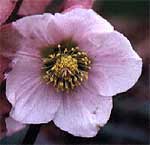 |
|
|
|
|
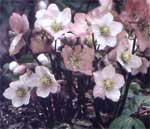 |
|
|
|
|
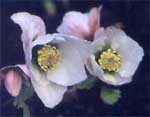 |
|
|
|
|
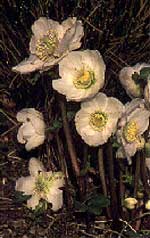 |
|
|
|
|
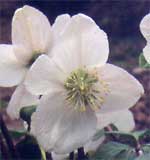 |
|
|
|
|
Words ©Graham Rice or © Graham Rice/Elizabeth Strangman 1993-2001. Pictures ©Graham Rice/gardenphotos.com unless stated. All Rights Reserved.